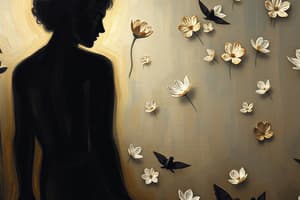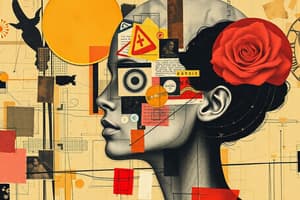Podcast
Questions and Answers
PRIMARY SEXUAL CHARACTERISTICS are changes to the sexual organs themselves such as uterus, vagina, penis, and testes. Secondary Sexual Characteristics refer to other visible changes that mark adult maturation such as changes in ______ and body shape.
PRIMARY SEXUAL CHARACTERISTICS are changes to the sexual organs themselves such as uterus, vagina, penis, and testes. Secondary Sexual Characteristics refer to other visible changes that mark adult maturation such as changes in ______ and body shape.
height
Body Image is the perception that a person has of their physical self and the thoughts and feelings that result from that perception. Imaginary audience is a state where an individual imagines and believes that multitudes of people are enthusiastically listening to or watching him or her. Spotlight Effect refers to the belief that others are paying more attention to the person’s appearance and behavior than they really are. FACTORS THAT AFFECT PERCEPTION OF THE PHYSICAL SELF include personal factors like Introspection, Self-Reflection, Self-Perception Theory, and Self-Concept, as well as social factors like Attachment Process and Social Appraisal, Maintaining, Regulating, and Expanding the Self in Interpersonal Relationships, The Looking Glass Self Theory, Social Comparison, and ______.
Body Image is the perception that a person has of their physical self and the thoughts and feelings that result from that perception. Imaginary audience is a state where an individual imagines and believes that multitudes of people are enthusiastically listening to or watching him or her. Spotlight Effect refers to the belief that others are paying more attention to the person’s appearance and behavior than they really are. FACTORS THAT AFFECT PERCEPTION OF THE PHYSICAL SELF include personal factors like Introspection, Self-Reflection, Self-Perception Theory, and Self-Concept, as well as social factors like Attachment Process and Social Appraisal, Maintaining, Regulating, and Expanding the Self in Interpersonal Relationships, The Looking Glass Self Theory, Social Comparison, and ______.
perception
Social Identity Theory discusses ______ THAT AFFECT PERCEPTION OF THE PHYSICAL SELF.
Social Identity Theory discusses ______ THAT AFFECT PERCEPTION OF THE PHYSICAL SELF.
FACTORS
______ is the process of observing one's internal state after behaving in a certain way.
______ is the process of observing one's internal state after behaving in a certain way.
According to the Self-Perception Theory, people can infer their inner states by observing their own ______.
According to the Self-Perception Theory, people can infer their inner states by observing their own ______.
Self-Concept is a cognitive representation of ______ which includes the sum total of all beliefs that people have about themselves.
Self-Concept is a cognitive representation of ______ which includes the sum total of all beliefs that people have about themselves.
John Bowlby emphasized the importance of ______ in the child's development of self-concept.
John Bowlby emphasized the importance of ______ in the child's development of self-concept.
People learn about their value and lovability when they experience how their ______ or caregivers care for them and respond to their needs
People learn about their value and lovability when they experience how their ______ or caregivers care for them and respond to their needs
Our sense of self is continuously shaped through ongoing interaction with others or with significant relationship partners, which Cooley (1902) refers to as the ______ Self-Theory
Our sense of self is continuously shaped through ongoing interaction with others or with significant relationship partners, which Cooley (1902) refers to as the ______ Self-Theory
Social Comparison is a process of comparing oneself with others in order to evaluate one’s own abilities and opinions, which can be either Upward social comparison or ______ social comparison
Social Comparison is a process of comparing oneself with others in order to evaluate one’s own abilities and opinions, which can be either Upward social comparison or ______ social comparison
Social Identity Theory (Collective Identity) states that peoples’ need for positive self-concept leads them to derive a part of their self-concept from their perceived membership in ______ groups
Social Identity Theory (Collective Identity) states that peoples’ need for positive self-concept leads them to derive a part of their self-concept from their perceived membership in ______ groups
PRIMARY SEXUAL CHARACTERISTICS are changes to the sexual organs themselves such as uterus, vagina, penis, and ______
PRIMARY SEXUAL CHARACTERISTICS are changes to the sexual organs themselves such as uterus, vagina, penis, and ______
Secondary Sexual Characteristics refer to other visible changes that mark adult maturation such as changes in voice and body ______
Secondary Sexual Characteristics refer to other visible changes that mark adult maturation such as changes in voice and body ______
The ______ gland is considered to be the 'master gland' of the endocrine system.
The ______ gland is considered to be the 'master gland' of the endocrine system.
______ is the most essential marker of the beginning of adolescence.
______ is the most essential marker of the beginning of adolescence.
The ______ self refers to the concrete dimensions of the body.
The ______ self refers to the concrete dimensions of the body.
Puberty is a brain-______ process occurring primarily in early adolescence.
Puberty is a brain-______ process occurring primarily in early adolescence.
The pituitary gland controls several other hormone glands including the ______ and adrenals.
The pituitary gland controls several other hormone glands including the ______ and adrenals.
The physical self is the ______ aspect of the person which can be directly observed.
The physical self is the ______ aspect of the person which can be directly observed.
Eurocentrism is a tendency to interpret the world in terms of ______ or Anglo-American values and experiences
Eurocentrism is a tendency to interpret the world in terms of ______ or Anglo-American values and experiences
Colorism is the prejudicial or preferential treatment of same race based solely on the ______ of their skin
Colorism is the prejudicial or preferential treatment of same race based solely on the ______ of their skin
A person with high self-esteem is likely to be ______
A person with high self-esteem is likely to be ______
People with positive body image tend to have high self-esteem and often spend more time taking care of their ______
People with positive body image tend to have high self-esteem and often spend more time taking care of their ______
Negative body image and low self-esteem can result when an individual does not measure up to how his culture defines ______
Negative body image and low self-esteem can result when an individual does not measure up to how his culture defines ______
Adolescents may resort to extreme negative behaviors in order to meet the so-called ______
Adolescents may resort to extreme negative behaviors in order to meet the so-called ______
Study Notes
Sexual Characteristics
- Primary sexual characteristics refer to changes in the sexual organs (uterus, vagina, penis, and testes) during puberty.
- Secondary sexual characteristics refer to other visible changes that mark adult maturation, such as changes in height and body shape.
Body Image
- Body image refers to a person's perception of their physical self and the thoughts and feelings that result from that perception.
- Imaginary audience refers to a state where an individual imagines and believes that multitudes of people are enthusiastically listening to or watching him or her.
- Spotlight effect refers to the belief that others are paying more attention to the person's appearance and behavior than they really are.
Factors that Affect Perception of the Physical Self
-
Personal factors:
- Introspection and self-reflection: observing one's internal state after behaving in a certain way.
- Self-perception theory: inferring internal states by observing one's own behavior, as if observing from outside.
- Self-concept: a cognitive representation of self-knowledge, including beliefs about oneself.
-
Social factors:
- Attachment process and social appraisal: learning about one's value and lovability through caregiving experiences.
- Maintaining, regulating, and expanding the self in interpersonal relationships: sense of self is shaped through ongoing interaction with others.
- Looking-glass self-theory: a person's self grows out of society's interpersonal interactions and perceptions of others.
- Social comparison: comparing oneself with others to evaluate one's abilities and opinions.
Physical Self and Identity
- Physical self refers to the concrete dimensions of the body, the tangible aspect of the person that can be directly observed and examined.
- Puberty is a brain-neuroendocrine process occurring primarily in early adolescence that triggers rapid physical changes.
- Pituitary gland is considered the "master gland" of the endocrine system, controlling several other hormone glands.
Culture on Body-Image and Self-Esteem
- Culture is a social system characterized by shared meanings attributed to people and events by its members.
- Beauty is the quality or aggregate of qualities in a person or thing that gives pleasure to the senses or pleasurably exalts the mind or spirit.
- Eurocentrism is a tendency to interpret the world in terms of European or Anglo-American values and experiences.
- Colorism is the prejudicial or preferential treatment of same-race individuals based solely on the color of their skin.
Filipino Concept of Beauty
- Self-esteem is an individual's subjective evaluation of their own worth.
- A person with high self-esteem is happier and will often spend more time taking care of their appearance.
- A person with a negative body image and low self-esteem may resort to extreme negative behaviors to meet cultural beauty standards.
Studying That Suits You
Use AI to generate personalized quizzes and flashcards to suit your learning preferences.
Description
Explore the different aspects of self and identity, demonstrate critical and reflective thought in integrating aspects of self and identity, identify forces and institutions impacting self development.




